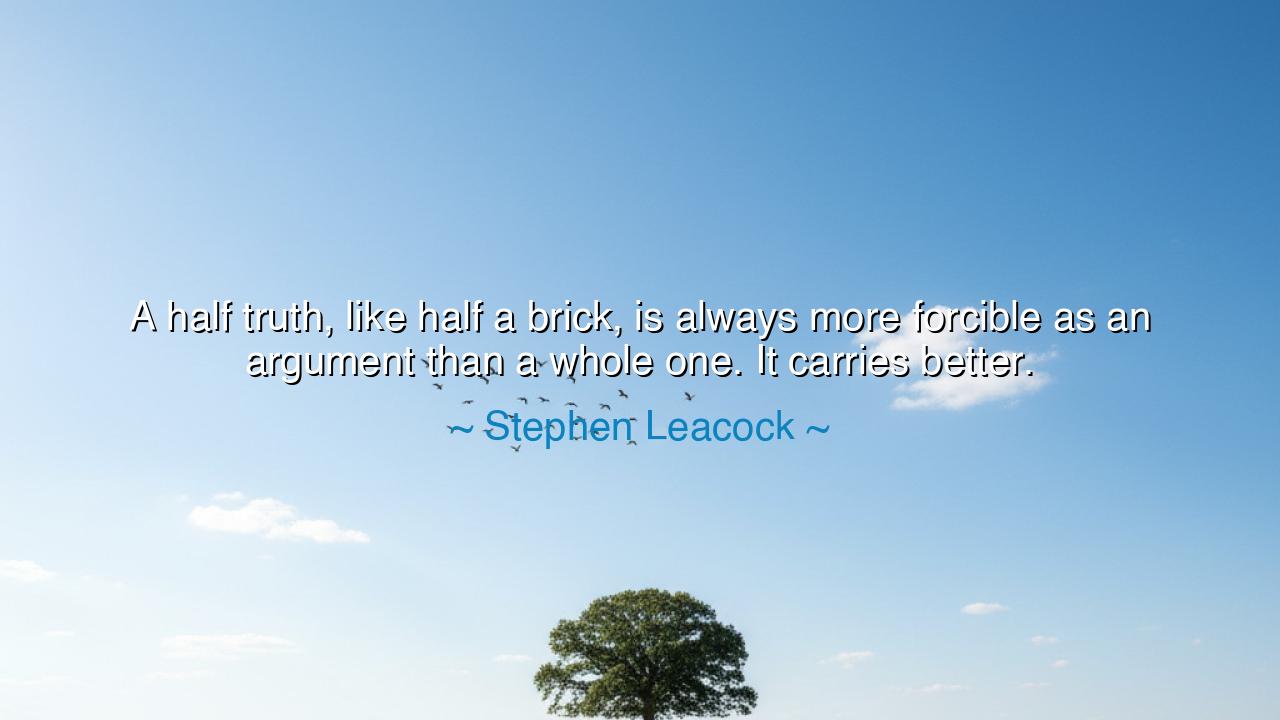
A half truth, like half a brick, is always more forcible as an
A half truth, like half a brick, is always more forcible as an argument than a whole one. It carries better.






The words of Stephen Leacock—“A half truth, like half a brick, is always more forcible as an argument than a whole one. It carries better.”—strike with humor, yet they conceal a profound and dangerous wisdom. In them we see the nature of deception, and the cunning way in which men wield fragments of truth as weapons. For a half truth is more dangerous than a lie, for it wears the garment of honesty while concealing its other half in shadow. Like a brick broken in two, it becomes sharper, easier to hurl, and more likely to wound than the whole.
The ancients knew this peril well. Sophists in Athens, clever with words, twisted fragments of reality into arguments that dazzled but did not enlighten. They would seize upon part of the truth and wield it as though it were the whole, swaying crowds, leading men astray, and causing confusion in the city. Socrates, in his dialogues, devoted his life to unmasking such deceptions. He showed that the half truth is more seductive than the outright lie, for it has just enough substance to appear trustworthy, and yet just enough falsehood to lead astray.
History offers grave examples of this danger. When Joseph Goebbels, the minister of propaganda in Nazi Germany, spread his words, they were seldom outright fabrications. Instead, they were half truths—facts twisted with venom, fragments of reality stripped from context and hurled like bricks at the minds of millions. The people, deceived by these fragments, were carried into one of history’s darkest chapters. Here we see the full meaning of Leacock’s metaphor: a whole truth is heavy, requiring thought, balance, and patience; but a half truth, sharp and broken, is quick to throw, and it strikes with terrible force.
The power of the half truth lies in its simplicity. The whole truth is often complex, demanding effort to grasp, requiring the weaving together of many threads. But a half truth is quick, simple, and easy to repeat. It fits into a slogan, a chant, a rumor that spreads like fire. Thus, it carries better, as Leacock said, because the human heart often desires the swift and simple answer, even when it is dangerous. Here lies the temptation: to choose the easy fragment over the difficult whole.
But the wise must resist this temptation. To live by whole truth is to live by patience, discipline, and courage. It means resisting the urge to strike quickly with half a brick, and instead to carry the whole weight of reality, even when it is harder, even when it does not win applause as swiftly. Whole truth builds, while half truth destroys. Whole truth heals, while half truth wounds.
The lesson for us is urgent: beware the seduction of the half truth. When you hear a claim that sounds pleasing, pause and ask: is this the whole? What is left unsaid? What lies behind the words? In your own speech, be slow to pass along fragments that you have not tested. Do not wield broken bricks, even if they strike harder, for they leave only wounds behind. Instead, labor to carry the whole truth, even if it is heavy, for though it carries less easily, it builds foundations that endure.
Practically, this means questioning every argument you hear—whether from leaders, teachers, or friends. Read beyond headlines, seek more than one source, and practice the discipline of context. In your own life, speak not what is convenient, but what is complete. Teach your children, your peers, and yourself to discern between the glimmer of a half truth and the solid light of the whole.
So let Leacock’s words stand as a warning carved into the memory of humankind: “A half truth, like half a brick, is always more forcible as an argument than a whole one.” Be not one who hurls fragments in haste, but one who bears the full weight of truth with integrity. For though the half brick wounds more swiftly, only the whole brick can build a lasting wall. And only the whole truth can build a life of wisdom, trust, and peace.






AAdministratorAdministrator
Welcome, honored guests. Please leave a comment, we will respond soon